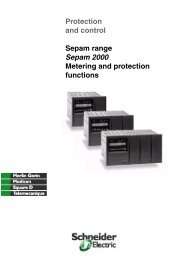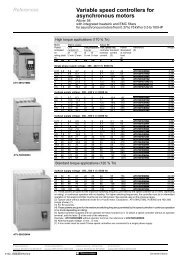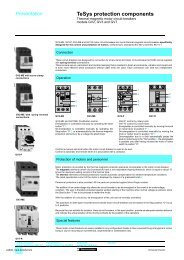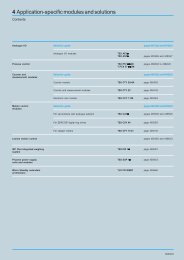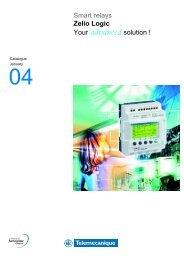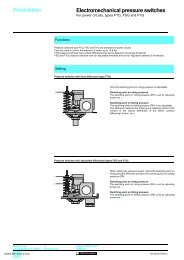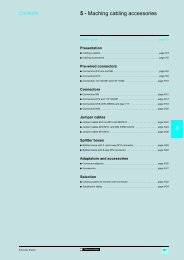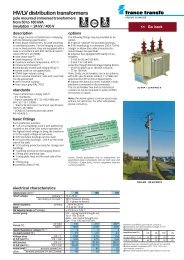Soft starters - Trinet
Soft starters - Trinet
Soft starters - Trinet
Create successful ePaper yourself
Turn your PDF publications into a flip-book with our unique Google optimized e-Paper software.
Functions (continued) <strong>Soft</strong> <strong>starters</strong> 0<br />
Altistart 48 soft start - soft stop units<br />
Logic output application functions<br />
The starter has 2 logic outputs (LO1 and LO2) which, depending on their<br />
configuration, can be used for remote indication of the following states or events:<br />
# Motor thermal alarm: Indicates that the motor thermal state has exceeded the<br />
alarm threshold and can be used for example to avoid starting a motor if the thermal<br />
reserve is insufficient.<br />
# Motor powered: Indicates that there may be current in the motor.<br />
# Motor overcurrent alarm: The motor current is higher than the threshold set.<br />
# Motor underload alarm: The motor torque is lower than the threshold set.<br />
# Motor PTC probe alarm: Indicates that the thermal state monitored by the PTC<br />
motor probe has been exceeded.<br />
# Second set of motor parameters activated<br />
Assigning the analogue output with PowerSuite on PC<br />
Relay and analogue output application functions<br />
The starter has 3 relays, 2 of which are configurable.<br />
# End of starting relay R2: Cannot be configured.<br />
The end of starting relay controls the bypass contactor on the starter. It is activated<br />
when the motor has completed the starting phase. It is deactivated when a stop<br />
command is sent and in the event of a fault. The starter regains control when a<br />
braking or deceleration command is sent.<br />
# Relay R1 application functions<br />
Relay R1 can be configured as follows:<br />
5 Fault relay: Relay R1 is activated when the starter is powered and there are no<br />
faults. It is deactivated when a fault occurs and the motor switches to freewheel<br />
mode.<br />
5 Isolating relay: The contact of relay R1 closes when a run command is sent and<br />
re-opens when a stop command is sent, at the end of deceleration on a decelerated<br />
stop or in the event of a fault. The line contactor is deactivated and the motor is<br />
isolated from the line supply<br />
(see application diagram page 60524/3).<br />
# Relay R3 application functions<br />
Relay R3 is configured to indicate the same states or events as logic outputs LO1 or<br />
LO2 (see above).<br />
# Analogue current output AO application functions<br />
5 The analogue output AO provides an image of the following values:<br />
motor current, motor torque, motor thermal state, cosine ϕ, active power.<br />
5 The following settings are associated with the analogue output:<br />
- the type of signal supplied: 0-20 mA or 4-20 mA<br />
- the scale setting of the signal. The function associates the maximum amplitude<br />
of the analogue output (20 mA) with a percentage of the nominal value of the<br />
parameter, which can be set between 50% and 500%.<br />
Function compatibility table<br />
Functions<br />
Decelerating<br />
stop<br />
Dynamic<br />
braking stop<br />
Forced<br />
freewheel<br />
stop<br />
Thermal<br />
protection<br />
Motor phase<br />
loss detection<br />
Connection to<br />
the motor<br />
delta terminal<br />
Tests on low<br />
power motor<br />
Cascaded<br />
motors<br />
Motor<br />
preheating<br />
Decelerating stop<br />
Dynamic braking<br />
stop<br />
Forced freewheel<br />
stop<br />
Thermal protection (1)<br />
Motor phase loss<br />
detection<br />
(1) (1)<br />
Connection to the<br />
motor delta terminal<br />
(1)<br />
Tests on low power<br />
motor<br />
Cascaded motors<br />
Motor preheating (2) (1)<br />
Compatible functions<br />
Incompatible functions<br />
Not applicable<br />
(1) Motor phase loss not detected.<br />
(2) Thermal protection is not provided during motor preheating.<br />
Schneider Electric<br />
60526_Ver1.10-EN.fm/9



